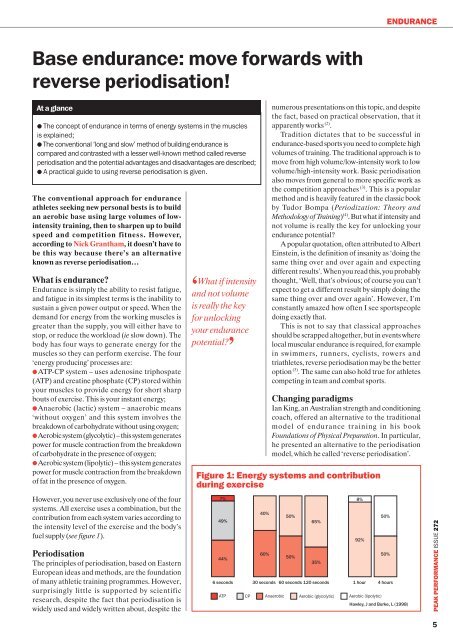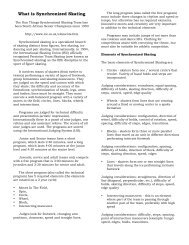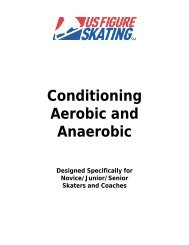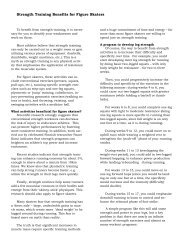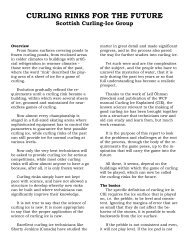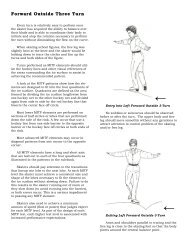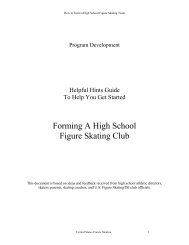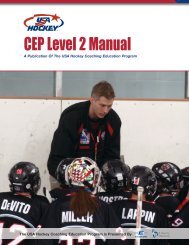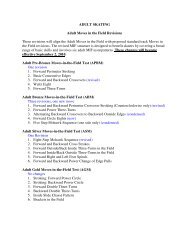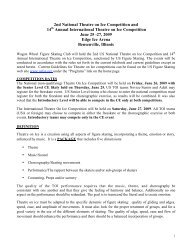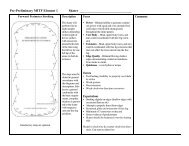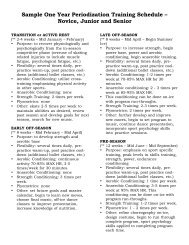Base endurance - Ice skating resources
Base endurance - Ice skating resources
Base endurance - Ice skating resources
You also want an ePaper? Increase the reach of your titles
YUMPU automatically turns print PDFs into web optimized ePapers that Google loves.
Endurance<br />
<strong>Base</strong> <strong>endurance</strong>: move forwards with<br />
reverse periodisation!<br />
At a glance<br />
l The concept of <strong>endurance</strong> in terms of energy systems in the muscles<br />
is explained;<br />
l The conventional ‘long and slow’ method of building <strong>endurance</strong> is<br />
compared and contrasted with a lesser well-known method called reverse<br />
periodisation and the potential advantages and disadvantages are described;<br />
l A practical guide to using reverse periodisation is given.<br />
The conventional approach for <strong>endurance</strong><br />
athletes seeking new personal bests is to build<br />
an aerobic base using large volumes of lowintensity<br />
training, then to sharpen up to build<br />
speed and competition fitness. However,<br />
according to Nick Grantham, it doesn’t have to<br />
be this way because there’s an alternative<br />
known as reverse periodisation…<br />
What is <strong>endurance</strong>?<br />
Endurance is simply the ability to resist fatigue,<br />
and fatigue in its simplest terms is the inability to<br />
sustain a given power output or speed. When the<br />
demand for energy from the working muscles is<br />
greater than the supply, you will either have to<br />
stop, or reduce the workload (ie slow down). The<br />
body has four ways to generate energy for the<br />
muscles so they can perform exercise. The four<br />
‘energy producing’ processes are:<br />
●●ATP-CP system – uses adenosine triphospate<br />
(ATP) and creatine phosphate (CP) stored within<br />
your muscles to provide energy for short sharp<br />
bouts of exercise. This is your instant energy;<br />
●●Anaerobic (lactic) system – anaerobic means<br />
‘without oxygen’ and this system involves the<br />
breakdown of carbohydrate without using oxygen;<br />
●●Aerobic system (glycolytic) – this system generates<br />
power for muscle contraction from the breakdown<br />
of carbohydrate in the presence of oxygen;<br />
●●Aerobic system (lipolytic) – this system generates<br />
power for muscle contraction from the breakdown<br />
of fat in the presence of oxygen.<br />
However, you never use exclusively one of the four<br />
systems. All exercise uses a combination, but the<br />
contribution from each system varies according to<br />
the intensity level of the exercise and the body’s<br />
fuel supply (see figure 1).<br />
Periodisation<br />
The principles of periodisation, based on Eastern<br />
European ideas and methods, are the foundation<br />
of many athletic training programmes. However,<br />
surprisingly little is supported by scientific<br />
research, despite the fact that periodisation is<br />
widely used and widely written about, despite the<br />
‘<br />
What if intensity<br />
and not volume<br />
is really the key<br />
for unlocking<br />
your <strong>endurance</strong><br />
potential? ’<br />
numerous presentations on this topic, and despite<br />
the fact, based on practical observation, that it<br />
apparently works (2) .<br />
Tradition dictates that to be successful in<br />
<strong>endurance</strong>-based sports you need to complete high<br />
volumes of training. The traditional approach is to<br />
move from high volume/low-intensity work to low<br />
volume/high-intensity work. Basic periodisation<br />
also moves from general to more specific work as<br />
the competition approaches (3) . This is a popular<br />
method and is heavily featured in the classic book<br />
by Tudor Bompa (Periodization: Theory and<br />
Methodology of Training) (4) . But what if intensity and<br />
not volume is really the key for unlocking your<br />
<strong>endurance</strong> potential?<br />
A popular quotation, often attributed to Albert<br />
Einstein, is the definition of insanity as ‘doing the<br />
same thing over and over again and expecting<br />
different results’. When you read this, you probably<br />
thought, ‘Well, that’s obvious; of course you can’t<br />
expect to get a different result by simply doing the<br />
same thing over and over again’. However, I’m<br />
constantly amazed how often I see sportspeople<br />
doing exactly that.<br />
This is not to say that classical approaches<br />
should be scrapped altogether, but in events where<br />
local muscular <strong>endurance</strong> is required, for example<br />
in swimmers, runners, cyclists, rowers and<br />
triathletes, reverse periodisation may be the better<br />
option (3) . The same can also hold true for athletes<br />
competing in team and combat sports.<br />
Changing paradigms<br />
Ian King, an Australian strength and conditioning<br />
coach, offered an alternative to the traditional<br />
model of <strong>endurance</strong> training in his book<br />
Foundations of Physical Preparation. In particular,<br />
he presented an alternative to the periodisation<br />
model, which he called ‘reverse periodisation’.<br />
Figure 1: Energy systems and contribution<br />
during exercise<br />
7%<br />
49%<br />
44%<br />
6 seconds<br />
40%<br />
60%<br />
50%<br />
50%<br />
65%<br />
35%<br />
30 seconds 60 seconds 120 seconds 1 hour 4 hours<br />
ATP CP Anaerobic Aerobic (glycolytic) Aerobic (lipolytic)<br />
8%<br />
92%<br />
50%<br />
50%<br />
Hawley, J and Burke, L (1998)<br />
PEAK PERFORMANCE ISSUE 272<br />
5
Endurance<br />
PEAK PERFORMANCE ISSUE 272<br />
Figure 2: A traditional model for the periodisation<br />
of <strong>endurance</strong><br />
1. Develop an ‘aerobic base’<br />
2. Develop foundations of specific <strong>endurance</strong> (threshold work)<br />
3. Carry out specific <strong>endurance</strong> work, together with and speed and power training<br />
4. Taper<br />
Aerobic Develop foundations of Specific<br />
<strong>endurance</strong> specific <strong>endurance</strong> <strong>endurance</strong><br />
Ian King describes his approach thus: ‘The<br />
“reverse” approach is based on maintaining<br />
intensity closer to that which the competition<br />
demands (recognising that initially, the athlete’s<br />
capacity to perform this intensity will be low) then<br />
to increase the volume progressively, without<br />
sacrificing the intensity. In summary, the goal is for<br />
the athlete to learn how to run fast over a distance<br />
that they are capable of running fast over, then to<br />
increase that distance. The difference in<br />
approaches of these two models is essentially this:<br />
the traditional model commences with capacity<br />
(volume) and shifts towards power (intensity). The<br />
alternative model, as the name suggests, reverses<br />
this approach, commencing with power then<br />
shifting toward capacity.’ (5)<br />
Although there’s a relative lack of research into<br />
the whole area of periodisation, this alternative<br />
approach makes intuitive sense, and people who<br />
made a living from coaching athletes such as<br />
Charles Poliquin and Istvan Bayli continued to<br />
contribute to its design and use. Here was a training<br />
method that could be applied across a wide range<br />
of sports, from <strong>endurance</strong> events such as swimming<br />
and running to team and combat sports.<br />
The model for reverse periodisation can be<br />
traced back to the ‘Eastern Bloc’ days. In his book<br />
Speed Trap, track coach Charlie Francis (who<br />
clearly understood the importance of training<br />
intensity) discussed how East German sprinters<br />
began their training at top speed over short<br />
distances, before increasing the distance as the<br />
season progressed. This training methodology was<br />
not reserved purely for sprinters; it was also used by<br />
East Germany’s competitive swimmers, who<br />
completed tough workouts in an endless pool (6) .<br />
Ian King’s argument was that what worked with<br />
speed and power athletes could also be of benefit<br />
to any sportsperson taking part in events that<br />
require an element of <strong>endurance</strong>. Key to his<br />
Fig 3: Reverse periodisation of <strong>endurance</strong><br />
1. Development of a ‘speed and power base’<br />
2. Develop foundations of specific <strong>endurance</strong><br />
3. Combination training (variety of duration/specificity)<br />
4. Taper<br />
‘<br />
It’s a lot to<br />
expect an athlete<br />
to spend months<br />
plodding around<br />
building an aerobic<br />
base, and then to<br />
suddenly crank up<br />
the speed and start<br />
working at higher<br />
intensities as the<br />
competition season<br />
approaches ’<br />
Specific Develop foundations of Aerobic<br />
<strong>endurance</strong> specific <strong>endurance</strong> <strong>endurance</strong><br />
rationale is the concept that speed <strong>endurance</strong> must<br />
be developed at the appropriate pace.<br />
The revised method pretty much flipped the<br />
more traditional approach on its head. Athletes<br />
using this method bypass the ‘aerobic base’ work of<br />
the traditional model (see figure 1)and start by<br />
training specific <strong>endurance</strong> and speed/power<br />
training before moving on to threshold work and<br />
then tapering (see figure 2). At no point are they<br />
moving slowly for long durations. This is significant,<br />
because while the traditional approach of<br />
developing an ‘aerobic base’ focuses on the central<br />
adaptations of the cardiovascular system (heart<br />
and lungs), it pays scant regard to the muscles used<br />
to actually move the body! As Ian King makes clear<br />
in his text on the subject, sports conditioning is not<br />
just about <strong>endurance</strong>, and certainly not just about<br />
the heart and lungs.<br />
The demands placed upon the musculoskeletal<br />
system at slow speeds are totally different to the<br />
demands placed upon it when working at higher<br />
intensities. It’s a lot therefore to expect an athlete<br />
to spend months plodding around building an<br />
aerobic base, and then to suddenly crank up the<br />
speed and start working at higher intensities as the<br />
competition season approaches. This is because<br />
you are essentially asking the musculoskeletal<br />
system to re-programme itself to cope with the<br />
increase in training intensity, yet the development<br />
of <strong>endurance</strong> goes hand-in-hand with the functional<br />
specialisation of the skeletal muscles (7) . The reverse<br />
periodisation theory says that if you want to<br />
compete at a certain intensity, why not start at that<br />
intensity and then build the volume; not only will<br />
you get central adaptations that will go a long way<br />
to developing a great heart and lungs, you will also<br />
develop the inter- and intra-muscular coordination<br />
required to compete at the appropriate intensity.<br />
In practice: <strong>endurance</strong> sports<br />
It is beyond the scope of this article to provide<br />
detailed training plans for all <strong>endurance</strong> sports (eg<br />
running, swimming, cycling, etc), but this section<br />
should provide you with some guiding principles<br />
that can be applied to any <strong>endurance</strong> sport. For the<br />
purpose of this next section it is useful to<br />
understand what intensity you should be working<br />
at and when. Box 1 (see opposite page, top) provides<br />
an outline of six training levels. This is just one<br />
system; you can work within your own training<br />
intensities as the underlying principle of<br />
developing power/intensity before capacity/<br />
volume remains the same.<br />
A traditional plan may start off with sessions<br />
focusing on Level One (L1) work (long, steady<br />
efforts) before moving on and adding in L2/L3/L6<br />
work, then later hitting L4 and building to L5.<br />
If you adopt the reverse periodisation approach,<br />
you can flip things on their head. You start with L4<br />
and L5, and then add L3. After these blocks you<br />
add L1/L2 and L6. You then cycle back to the L3/<br />
L4/L5 as a focus later in the season, either right<br />
6
Endurance<br />
Box 1: The six training levels (L) for <strong>endurance</strong> sports<br />
l Level One (<strong>endurance</strong>: 3+ hours) This level is pretty much<br />
where most people naturally default to. You are not going to stress<br />
the body enough to improve your aerobic fitness<br />
l Level Two (aerobic capacity tempo: 45mins+) This level can<br />
be considered as your tempo workload and this is where you will<br />
start to make gains in your aerobic capacity<br />
l Level Three (aerobic capacity – lactate threshold: 8-20mins)<br />
This is your lactate threshold (LT) work, where you increase the level<br />
you can work at before lactic acid builds up and stops you. LT training<br />
is one of the most important areas for training gains<br />
l Level Four (maximum aerobic power – VO 2 max: 3-8mins)<br />
This is a borderline anaerobic level where you increase your VO 2 max,<br />
which helps train the body to clear lactic acid more efficiently<br />
l Level Five (anaerobic capacity: 30s-3mins) This level is<br />
anaerobic, high intensity and where the demand for energy<br />
surpasses that which can be supplied by aerobic system. This<br />
training is often combined with Level Four training;<br />
l Level Six (anaerobic power (about 10s) At this level you are<br />
sprinting. This is a level (extremely high intensity) that needs to be<br />
trained all year round.<br />
before or right after events, or both. The idea<br />
behind reverse periodisation is that you develop<br />
your power first, and then you train yourself to<br />
maintain it. Then you add it to your normal base/<br />
tempo sessions that act as race simulations.<br />
Team and combat sports<br />
The <strong>endurance</strong> fraternity have not been the only<br />
ones to adopt the traditional method of developing<br />
<strong>endurance</strong>. But just because a football match lasts<br />
90 minutes and a rugby match lasts 80 minutes<br />
does not mean you have to be able to maintain a<br />
constant workload for those time-frames. The<br />
same also applies to boxers and other combat<br />
athletes. Just because a boxing contest may last for<br />
more than half an hour, it doesn’t mean you have<br />
to get up at 5am for a six-mile run! You fight in<br />
three-minute rounds and your workload during<br />
each round is intermittent in nature. Reverse<br />
periodisation is a much more sensible approach<br />
for getting match- and fighting-fit. Here is a<br />
suggestion for developing <strong>endurance</strong> in team and<br />
combat sports.<br />
A traditional <strong>endurance</strong> plan for team/combat<br />
sport would almost certainly start off with sessions<br />
focusing on developing long-term aerobic<br />
<strong>endurance</strong> before moving on and adding in some<br />
short-term aerobic <strong>endurance</strong>. Once the base has<br />
been established, more time would be spent<br />
developing anaerobic capacity before finally<br />
working on what is arguably the most important<br />
<strong>endurance</strong> sub-quality for team and combat sport,<br />
anaerobic power.<br />
Adopting a reverse approach, however, makes<br />
more sense. When I train my team and combat<br />
sport athletes, we start with very short, highintensity<br />
efforts to develop anaerobic power. We<br />
then spend time on establishing anaerobic capacity<br />
before finally developing aerobic power and<br />
capacity (see table 1).<br />
As we move closer to the business end of the<br />
season, we start to mix things up and add a variety<br />
of sessions that tax all of the <strong>endurance</strong> subqualities,<br />
in much the same way as those you would<br />
experience during a match or bout.<br />
Conclusion<br />
This article is not suggesting that we completely<br />
scrap the more classical approaches – simply that,<br />
Table 1: An overview of the <strong>endurance</strong> sub-qualities that<br />
team and combat sport athletes need to emphasise<br />
Sub-quality<br />
Anaerobic<br />
Aerobic<br />
ST<br />
LT<br />
ST<br />
LT<br />
Work<br />
10-60<br />
secs<br />
60-120<br />
secs<br />
2-6<br />
mins<br />
6+<br />
mins<br />
if you have fallen into the trap of repeating yourself<br />
year after year, now may be a good time for a<br />
different approach. For example, if cycling or<br />
running is your thing, you’ll be very aware of the<br />
short days during the winter months and the<br />
problems of trying to train outside in the dark.<br />
With a reduced ‘after-work’ training time available,<br />
it makes sense to train more intensely during the<br />
winter and to increase the longer rides and runs as<br />
the evenings draw out – exactly the approach of<br />
reverse periodisation. So maybe it’s time to stop<br />
following the crowd and try something new in your<br />
training methods – after all, what have you got to<br />
lose? You may find you have plenty to gain…<br />
Nick Grantham is a strength and conditioning coach<br />
who has worked with elite athletes for the past<br />
10 years. He has trained many of the country’s<br />
elite athletes, including Olympic and Paralympic<br />
finalists, and professionals in a multitude of sports.<br />
He now heads the Strength and Conditioning team<br />
at GENR8 Fitness<br />
Practical implications<br />
Ratio of<br />
work to<br />
recovery<br />
1:0.5-1.3<br />
Duration Frequency Intensity<br />
*15-30<br />
mins<br />
*15-30<br />
mins<br />
30+<br />
mins<br />
30+<br />
mins<br />
LT = long-term; ST = short-term; MHR = maximum heart rate<br />
*Does not include warm-up or cool-down or recovery periods.<br />
1-4 per<br />
week<br />
Depends<br />
on the<br />
purpose of<br />
training,<br />
but for<br />
intervals<br />
70%+<br />
MHR<br />
References<br />
1. Hawley, J, & Burke, L,<br />
Peak Performance: training<br />
and nutritional strategies for<br />
sport. Allen & Unwin (1998)<br />
2. Cissik, J, Hedrick, A,<br />
Barnes, M, NSCA J: 30 (1):<br />
45-51 (2008)<br />
3. Marshall, J, Peak<br />
Performance: 198 (June)<br />
(2004)<br />
4. Bompa, T, Periodization:<br />
Theory and Methodology<br />
of Training (4th Edition).<br />
Champaign, Illinois:<br />
Human Kinetics (1999)<br />
5. King, I, Foundations of<br />
Physical Preparation. King<br />
Sports Publishing (2000)<br />
6. Francis, C, Speed Trap:<br />
Inside the Biggest Scandal<br />
in Olympic History. Grafton<br />
Books (1991)<br />
7. Siff, M, Supertraining<br />
(4th Edition) Supertraining<br />
Institute; 6th edition (2003)<br />
●● Experienced <strong>endurance</strong> athletes with a good existing aerobic base may<br />
gain performance advantages with a reverse periodisation approach,<br />
particularly where speed is also required<br />
●● Reverse periodisation is less suitable for novice or very de-conditioned<br />
athletes and should therefore be used with caution.<br />
PEAK PERFORMANCE ISSUE 272<br />
7


